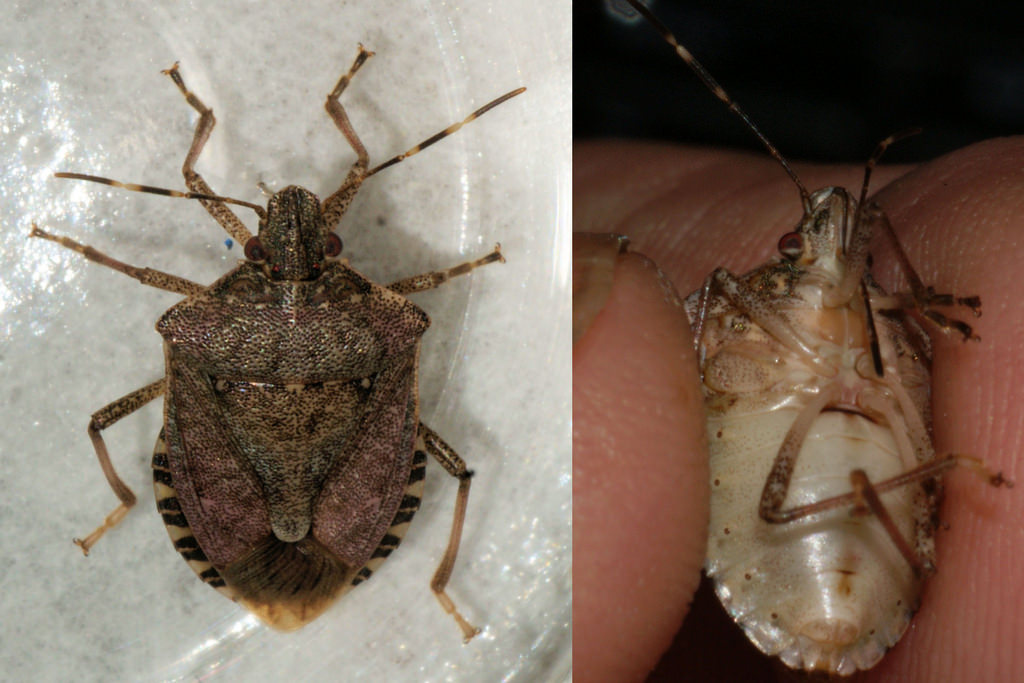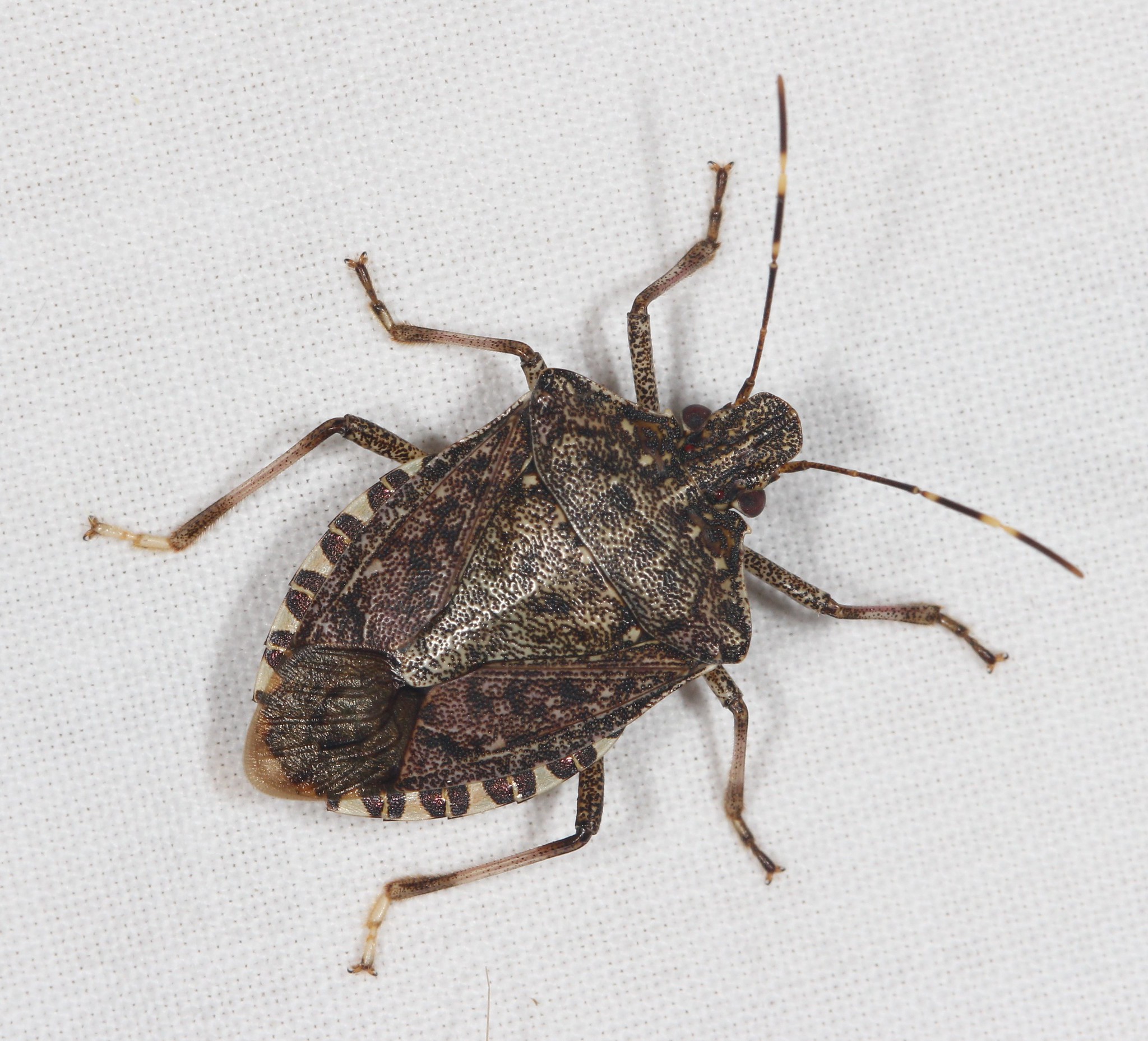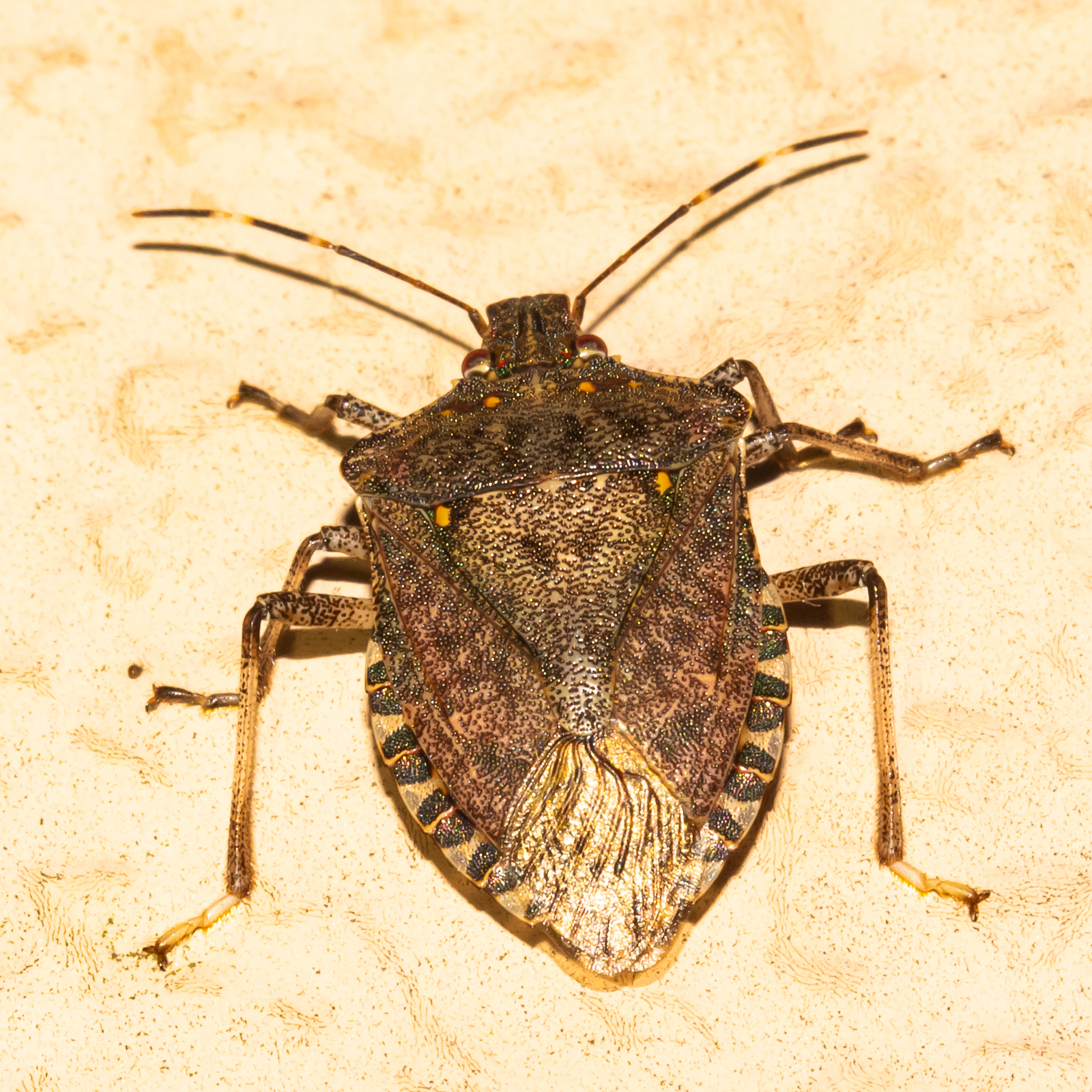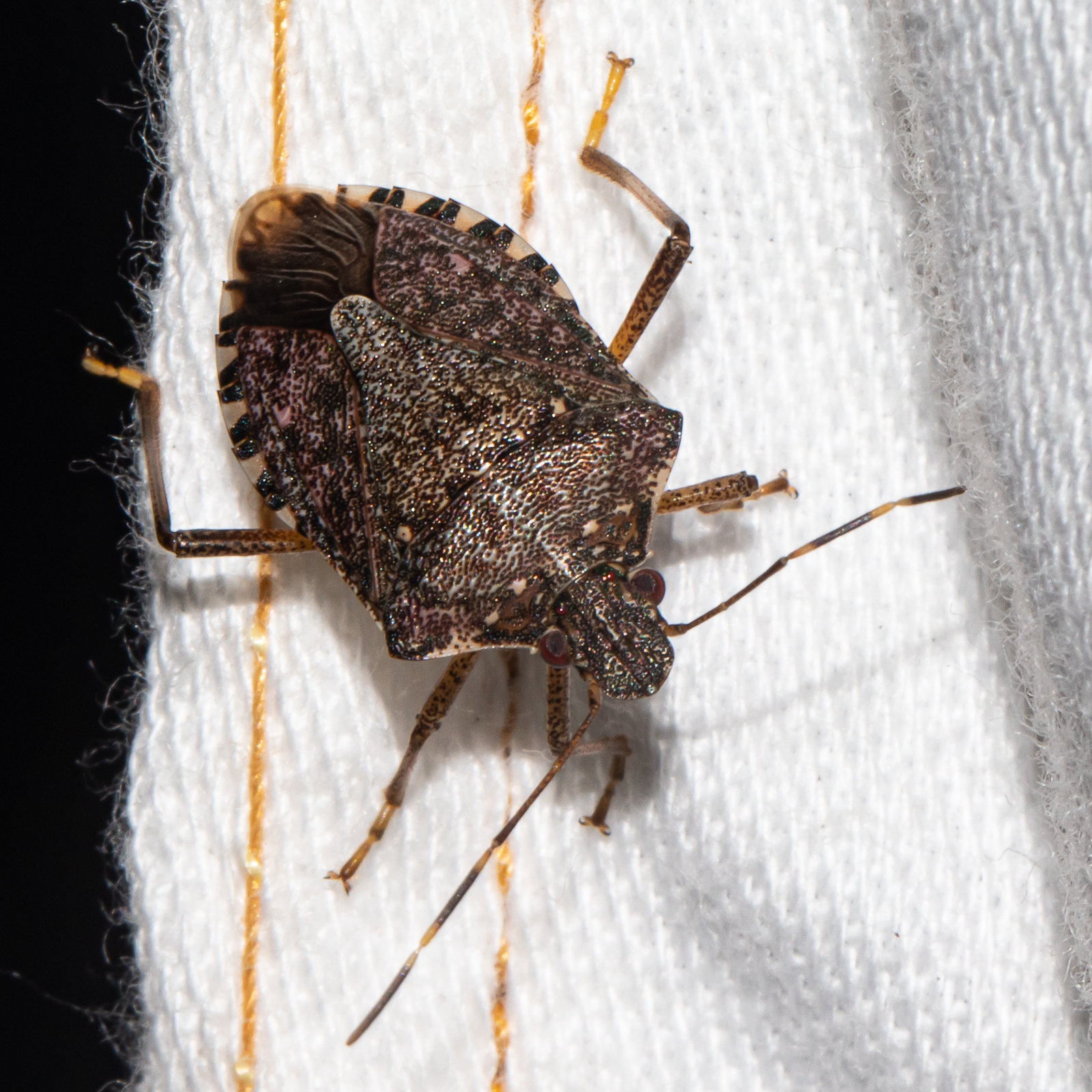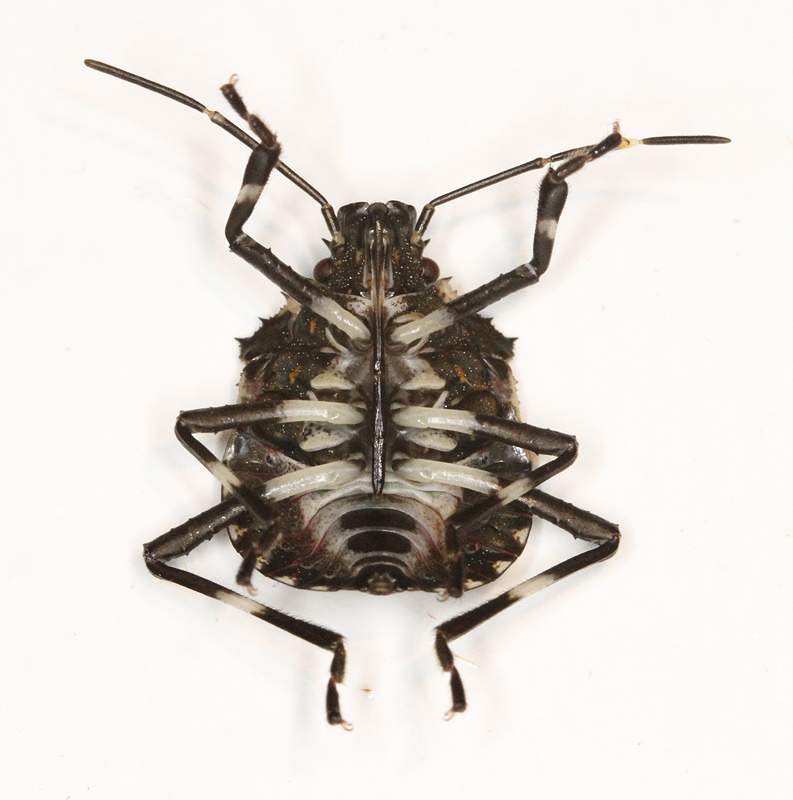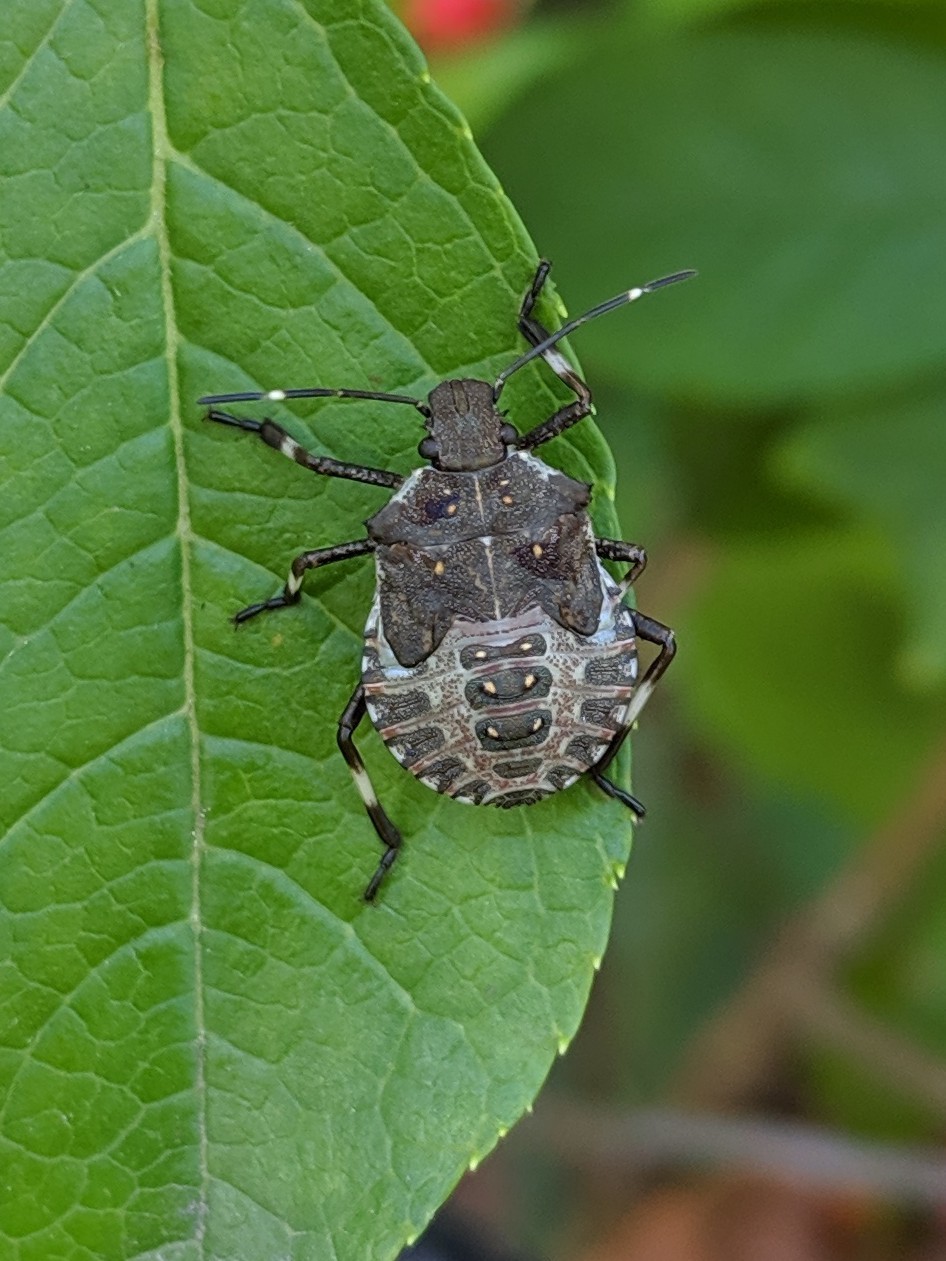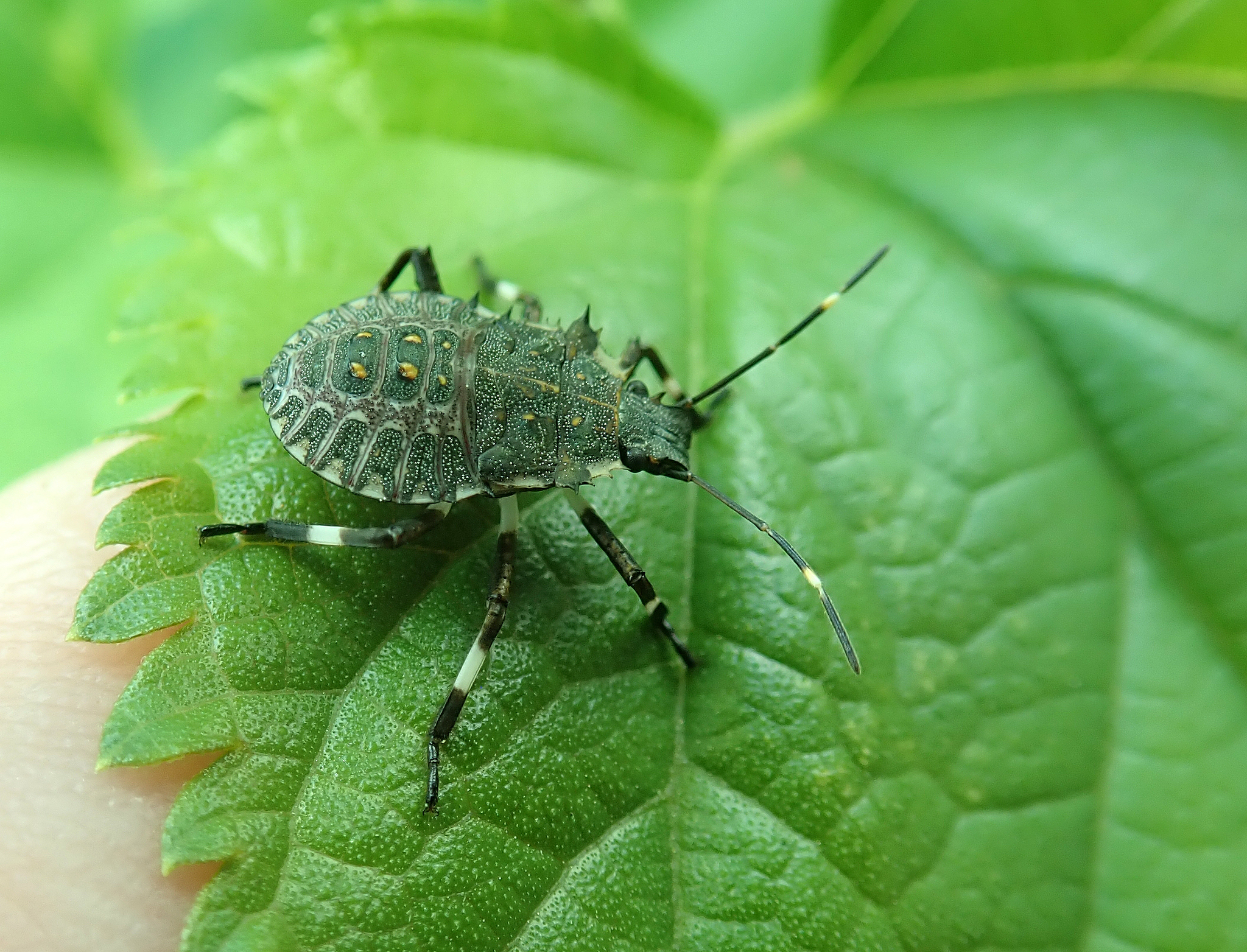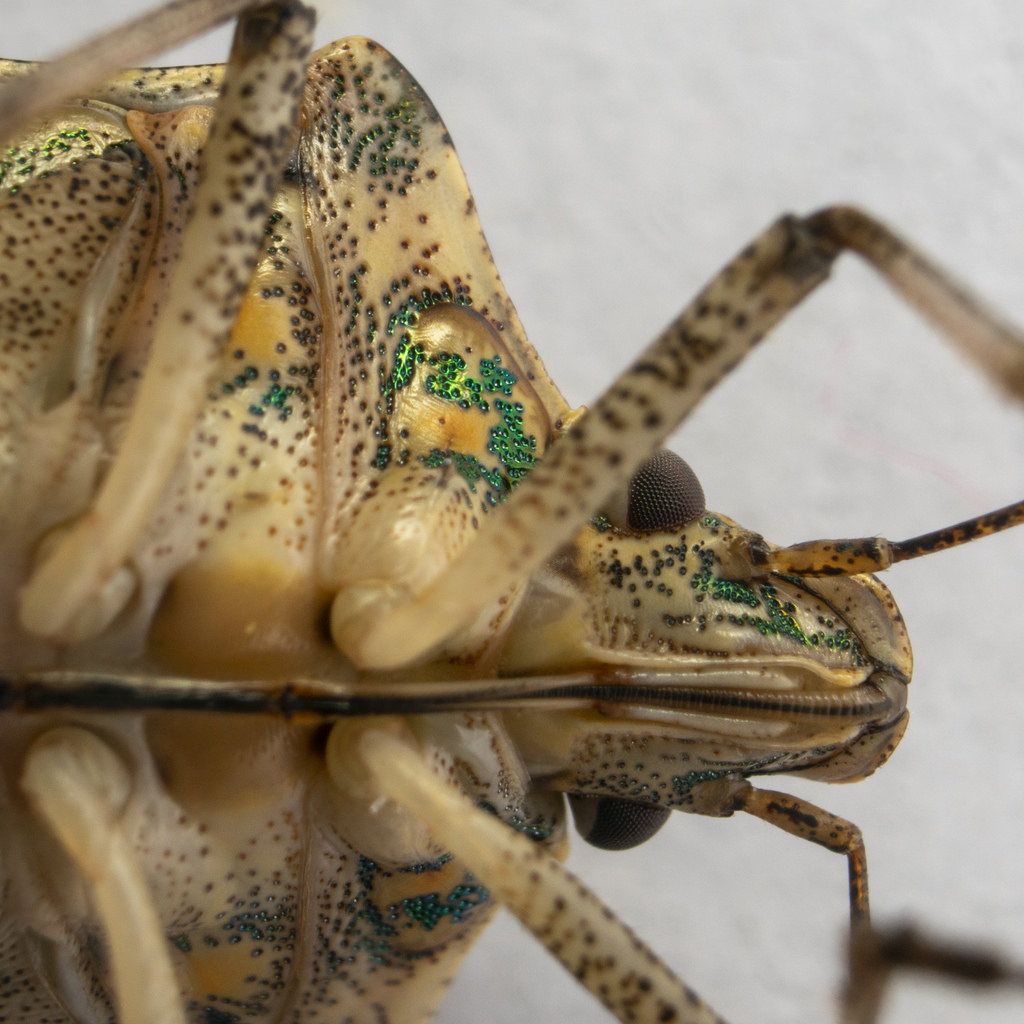Map Snapshot

























1,605 Records
Status
The Brown Marmorated Stink Bug is an insect that originated in east Asia and has become a serious agricultural pest in the United States. It attacks fruits, vegetables and ornamental plants.
Description
Banded antennae rule out similar, native stink bugs.
Relationships
Brown Marmorated Stink Bugs have few predators. Bats and mantises are known to attack them, and bluebirds have been documented feeding them to their young.
Seasonality Snapshot
Source: Wikipedia
| Brown marmorated stink bug | |
|---|---|

| |
| Adult | |
| Scientific classification | |
| Domain: | Eukaryota |
| Kingdom: | Animalia |
| Phylum: | Arthropoda |
| Class: | Insecta |
| Order: | Hemiptera |
| Suborder: | Heteroptera |
| Family: | Pentatomidae |
| Genus: | Halyomorpha |
| Species: | H. halys
|
| Binomial name | |
| Halyomorpha halys | |
The brown marmorated stink bug (Halyomorpha halys) is an insect in the family Pentatomidae, native to China, Japan, Korea, and other Asian regions.[2] In September 1998, it was collected in Allentown, Pennsylvania, where it is believed to have been accidentally introduced.[3] The nymphs and adults of the brown marmorated stink bug feed on over 100 species of plants, including many agricultural crops,[4] and by 2010–11 had become a season-long pest in orchards in the Eastern United States.[5] In 2010, in the Mid-Atlantic United States, $37 million in apple crops were lost, and some stone fruit growers lost more than 90% of their crops.[6] Since the 2010s, the bug has spread to countries such as Georgia and Turkey and caused extensive damage to hazelnut production. It is now established in many parts of North America, and has recently become established in Europe and South America.[7]
Description
[edit]Adult brown marmorated stink bugs are approximately 1.7 cm (0.67 in) long and about as wide, forming the heraldic shield shape characteristic of bugs in the superfamily Pentatomoidea. They are generally a dark brown when viewed from above, with a creamy white-brown underside. Individual coloration may vary, with some bugs being various shades of red, grey, light brown, copper, or black. The term "marmorated" means variegated or veined, like marble,[8] which refers to the markings of this species, including alternating light-colored bands on the antennae and alternating dark bands on the thin outer edge of the abdomen. The legs are brown with faint white mottling or banding.[6]
The nymph stages are black or very dark brown, with red integument between the sclerites. First instar nymphs have no white markings, but second through fifth instar nymphs have black antennae with a single white band. The legs of nymphs are black with varying amounts of white banding.[6] Freshly molted individuals of all stages are pale white with red markings. Eggs are normally laid on the underside of leaves in masses of 28 eggs, and are light green when laid, gradually turning white.[6]
Like all stink bugs, the glands that produce the defensive chemicals (the smell) are located on the underside of the thorax, between the first and second pair of legs.[9]
Behavior
[edit]The odor from the stink bug is due to trans-2-decenal and trans-2-octenal.[10] The smell has been characterized as a "pungent odor that smells like coriander."[5] The stink bug's ability to emit an odor through holes in its thorax is a defense mechanism evolved to prevent it from being eaten by birds and lizards. However, simply handling the bug, injuring it, or attempting to move it can trigger it to release the odor.
Reports on human cases are rare, but the stink bug's body fluids are toxic and irritating to the human skin and eyes. One case of keratitis has been reported in Taiwan.[11]
Mating
[edit]During courtship, the male emits pheromones and vibrational signals to communicate with a female, which replies with her own vibrational signals, as in all stink bugs. The insects use the signals to recognize and locate each other. Vibrational signals of this species are noted for their low frequency, and one male signal type is much longer than any other previously described signals in stink bugs, although the significance of this is not yet clear.[12]
Diet
[edit]The brown marmorated stink bug is a sucking insect (like all Hemiptera or "true bugs") that uses its proboscis to pierce the host plant to feed. This feeding results, in part, in the formation of dimpled or necrotic areas on the outer surface of fruits, leaf stippling, seed loss, and possible transmission of plant pathogens. It is an agricultural pest that can cause widespread damage to fruit and vegetable crops. In Japan, it is a pest to soybean and fruit crops. In the U.S., the brown marmorated stink bug feeds, beginning in late May or early June, on a wide range of fruits, vegetables, and other host plants including peaches, apples, green beans, soybeans, cherries, raspberries, and pears.[citation needed]
In North America
[edit]
The brown marmorated stink bug was accidentally introduced into the United States from China or Japan. It is believed to have hitched a ride as a stowaway in packing crates or on various types of machinery. The first documented specimen was collected in Allentown, Pennsylvania, in September 1998.[4][13] Several Muhlenberg College students were reported to have seen these bugs as early as August of that same year.[14][15] Between 2001 and 2010, 54 sightings were reported of these bugs at shipping ports in the United States.[16] However, stink bugs are not listed as reportable and no action is required to remove the insect. This allowed the insect to enter the United States relatively easily, as they are able to survive long periods of time in hot or cold conditions.
Other reports have the brown marmorated stink bug documented as early as 2000 in New Jersey from a blacklight trap run by the Rutgers Cooperative Extension Vegetable Integrated Pest Management program in Milford, New Jersey.[17]
In 2002, in New Jersey, it was found on plant material in Stewartsville, and was collected from blacklight traps in Phillipsburg and Little York. It was quickly documented and established in many counties in Pennsylvania, New Jersey, Delaware, Connecticut, and New York on the eastern coast of the United States.
By 2009, this agricultural pest had reached Maryland, West Virginia, Virginia, Tennessee, North Carolina, Kentucky, Ohio, Illinois, and Oregon.[18] In 2010 it was found in Indiana,[19] Michigan,[20] Minnesota,[21] and other states.[22]
As of November 2011, it had spread to 34 U.S. states[5] and by 2012 to 40, and showed an increase of 60% in total numbers over 2011.[23]

Their populations have also spread to southern Ontario and Quebec, Canada.[24][25] They have recently been found in southern British Columbia [26] and Southern Alberta.
Population increase
[edit]
As of 2010, 17 states had been categorized as having established populations, and several other states along the eastern half of the United States were reported as having more than normal numbers of stink bugs.[27][28] Stink bug populations rise because the climate in the United States is ideal for their reproduction. In optimal conditions, an adult stink bug can develop within 35 to 45 days after hatching.[16] Female stink bugs are capable of laying 400 eggs in their lifetimes.[29] The bug is also capable of producing at least one successful generation per year in all areas of the United States, no matter the climate. In warmer climates, multiple generations can occur annually, which can range from two generations in states such as Virginia to six generations in California, Arizona, Florida, Louisiana, Georgia, and Texas.[16][30][31]
The addition of two more generations allowed the population to explode, leading to the establishment of several other populations in neighboring states. Currently, no environmental limiting factors are apparently slowing their distribution across North America. They also are extremely mobile insects, capable of moving from host to host without causing disruption in their reproductive processes. Currently, populations are estimated to continue to grow and spread to other states and provinces, especially during unusual periods of warm weather.[citation needed]
Agricultural effects
[edit]
The brown marmorated stink bug is a serious agricultural pest that has been readily causing damage to crops across the Eastern United States. They feed on a wide array of plants including apples, apricots, Asian pears, cherries, corn, grapes, lima beans, peaches, peppers, tomatoes, and soybeans.[32] This makes them extremely versatile, as they do not require a specific plant on which to feed. To obtain their food, stink bugs use their stylets to pierce the plant tissue to extract the plant fluids.[33] In doing so, the plant loses necessary fluids, which can lead to deformation of seeds, destruction of seeds, destruction of fruiting structures, delayed plant maturation, and increased vulnerability to harmful pathogens.[33] While harvesting the plant's juices, the stink bug injects saliva into the plant, creating a dimpling of the fruit's surface and rotting of the material underneath.
The most common signs of stink bug damage are pitting and scarring of the fruit, leaf destruction, and a mealy texture to the harvested fruits and vegetables. In most cases, the signs of stink bug damage makes the plant unsuitable for sale in the market, as the insides are usually rotten. In field crops such as corn and soybeans, the damage may not be as evident as the damage seen in fruit plants. When stink bugs feed on corn, they go through the husk before eating the kernels, hiding the damage until the husks are removed during harvesting. The same damage is seen in soybeans, as the stink bug goes through the seed pods to acquire the juices of the seeds. One visual cue of stink-bug damage to soybean crops is the "stay green" effect, where damaged soybean plants stay green late into season, while other plants in the field die off normally. One can usually tell that a field of crops is infected because stink bugs are known for the "edge effect", in which they tend to infest crops 30–40 ft from the edge of the field.
Control
[edit]Control of stink bugs is a priority of the United States Department of Agriculture, which has developed an artificial pheromone which can be used to bait traps.[34][35] Because the bugs insert their probosces below the surface of fruit and then feed, some insecticides are ineffective; in addition, the bugs are mobile, and a new population may fly in after the resident population has been killed, making permanent removal nearly impossible. In the case of soybean infestations, spraying only the perimeter of a field may be the most effective method of preventing stinkbugs from damaging the crops. However, even this method is limited, as new populations move back into the area, or the existing population simply moves to unaffected areas. Evidence also shows that stink bugs are developing a resistance to pyrethroid insecticides, a common chemical used to combat infestations.[16] Other insecticides currently in field trials that are showing promising results are oxamyl (96% mortality rate) and moribund (67% mortality rate).[16] Many other commonly used insecticides are merely used to keep the insects out of fields, rather than actually killing them. The most successful method of protecting apples found thus far is the use of kaolin clay.[16] As of 2012[update], native predators such as wasps and birds were showing increased signs of feeding on the bugs as they adapt to the new food source.[23] Managing this pest species is challenging, because few effective pesticides are labeled for use against them.
Another recently introduced species from Asia, the large but non-threatening spider; Trichonephila clavata, also known as the Joro spider is a known predator of the stink bug while not posing a threat to native species. There is hope that it may be capable of reducing or controlling stink bug populations in North America as it continues to spread.[citation needed]
Similarity in appearance to native species
[edit]Easily confused with Brochymena and Euschistus, the best identification for adults is the white band on the antennae. It is similar in appearance to other native species of shield bug, including Acrosternum, Euschistus, and Podisus, except that several of the abdominal segments protrude from beneath the wings and are alternatively banded with black and white (visible along the edge of the bug even when wings are folded) and a white stripe or band on the next to last (fourth) antennal segment.[36] The adult rice stink bug (Oebalus pugnax) is distinguishable from the brown marmorated stink bug by noting the straw color, the smaller size, and the elongated shape of the rice stink bug.[37]
In Europe
[edit]The brown marmorated stink bug was likely first introduced to Europe during the repair work of the Chinese Garden in Zürich, Switzerland in the winter of 1998. The stink bug has been traced back to have traveled with roof tiles that were imported from Beijing, China.[38] The bug has since spread rapidly through Europe. The first sighting in southern Germany was made in Konstanz in 2011.[39] In Italy the first specimens were found in Modena in 2012[40] and afterwards in South Tirol in 2016.[41] The bug has also been sighted in Vienna, Austria, with increasing reports after 2016.[42] The Italian region of Friuli-Venezia Giulia announced from 2017 to distribute 3.5 million euros to offset the costs of the lost crops of the fruit farmers until 2020.[43] H. halys was first found in Portugal in Pombal in late 2018 or early 2019[44] - a few live specimens were found in agricultural equipment being imported from Italy.[44] However the Portuguese National Authority for Animal Health regards this as a transitory interception.[44] In 2019, there may have been another sighting somewhere in Portugal.[45] In 2018 arrived to the Basque Country, where the population grew rapidly by October 2023.[46] Only in 2020 was H. halys confirmed to be reproducing and overwintering in the country.[44] In March 2021, it was confirmed to have arrived in the UK.[47][48][49]
Spread from Russia to Georgia
[edit]The stink bug was traced to have been introduced to the Greater Caucasus area during the construction works of the 2014 Winter Olympics in Sochi, Russia, where it was most likely imported with decorative building elements brought from Italy.[50] The stink bug has since spread to Georgia, where it continues to cause major damage to the local crops. From 2016 to 2018 the bug was estimated to have destroyed one-third of Georgia's hazelnut harvest, with yearly damages of up to €60 million[38] (~![]() 179,000,000 in 2018 lari). Georgia is the fifth-largest producer of hazelnut in the world, with yearly production valued at US$179.5 million in 2016. In 2018 the Georgian government allocated
179,000,000 in 2018 lari). Georgia is the fifth-largest producer of hazelnut in the world, with yearly production valued at US$179.5 million in 2016. In 2018 the Georgian government allocated ![]() 4 million ($1.6 million) and the United States Agency for International Development (USAID)
4 million ($1.6 million) and the United States Agency for International Development (USAID) ![]() 8 million ($3.2 million) to help combat the spread of the brown marmorated stink bug in Georgia, but so far the efforts have been criticized as being insufficient.[51]
8 million ($3.2 million) to help combat the spread of the brown marmorated stink bug in Georgia, but so far the efforts have been criticized as being insufficient.[51]
Spread to Turkey
[edit]The stink bug was first reported in Levent district of Istanbul in Turkey in September 2017.[52] In October of the same year, it was observed in Artvin Province[53][54] and the species has rapidly spread to other areas in Eastern Black Sea Region. In 2018, it was reported in Sakarya's Hendek district,[55] and as of January 2020[update], it is present in 8 provinces and 46 districts all across Turkey, with Artvin, Rize, Trabzon, Giresun, Samsun, and Yalova provinces being the most effected.[56] The bug is believed to have entered the country through Georgia, as it was initially reported in Kemalpaşa, Artvin just few kilometers away from the border between both countries.[53][54]
Since Turkey is the biggest hazelnut producer in the world, the bug has caused extensive damage to hazelnut agriculture. The damages on the hazelnut industry in Turkey has been estimated to be US$200 million in 2017, US$300 million in 2018 and is mainly attributed to the brown marmorated stink bug, green stink bug and the powdery mildew.[57] Celal Tuncer, a professor from the Ondokuz Mayıs University has stated that the bug has already caused a 20% drop in Artvin's hazelnut yield and is expected to cause a 50% drop in hazelnut production and quality in the future. According to Tuncer, these drops would lead to US$1 billion in damages to hazelnut producers.[58]
Predators
[edit]In China, Trissolcus japonicus,[59] a parasitoid wasp species in the family Scelionidae, is a primary predator.[60]
In the United States, Europe, and New Zealand, Trissolcus japonicus is a focus of biological control programs against the brown marmorated stink bug.[61] This wasp was under study in the United States since 2007 for biosafety of possible introduction.[5][62] However, in 2014, two adventive populations were found in the United States during surveys to identify which North American parasitoids might be attacking brown marmorated stink bug.[63][64] Subsequent genetic testing showed these wild populations were self-introduced: they were not related to each other, or to a laboratory strain being studied in quarantine.[62] Since then, several agricultural authorities have begun programs to augment wild populations with releases of laboratory reared wasps.[65][66][67] An adventive European population was discovered during similar surveys in Switzerland in 2017.[68]
Several parasitoids and predators indigenous to North America and Europe have been reported to attack stink bug eggs, nymphs and adults.[69][70] Researchers have also experimented with other predators like the spotted lady beetle, the spined soldier bug and the common green lacewing, whereby the latter consumed most of the eggs of these tested species.[71] Other research investigated different spider species, as well as the wheel bug Arilus cristatus. Several spider species attacked both the eggs and adult stink bugs. The Joro spider, another invasive Asian species, was identified in Georgia in 2015, and is a natural predator of the stink bug.[72] Pill bugs eat stink bug eggs.[73] Arilus cristatus, however, was the most voracious predator and attacked the eggs and adults more consistently.[74]
Life cycle
[edit]-
Eggs on leaf
-
Newly hatched eggs
-
Newly hatched eggs
-
Nymph
-
Third or fourth instar nymph
-
Fifth-instar nymph
-
Adult
-
Adult
-
Laying eggs
In houses and structures
[edit]The brown marmorated stink bug is more likely to invade homes in the fall than others in the family.[14] The bug survives the winter as an adult by entering houses and structures when autumn evenings become colder, often in the thousands. In one home, more than 26,000 stinkbugs were found overwintering.[75] Adults can live from several months to a year.[76][77] They enter under siding, into soffits, around window and door frames, chimneys, or any space which has openings big enough to fit through. Once inside the house, they go into a state of hibernation. They wait for winter to pass, but often the warmth inside the house causes them to become active, and they may fly clumsily around light fixtures. Two important vectors of this pest are the landscape ornamentals tree of heaven and princess tree.[78]
See also
[edit]- Stink bug
- Acrosternum hilare, the green stink bug
- Megacopta cribraria, the kudzu bug
- Nezara viridula, the southern green stink bug
- Oebalus pugnax, the rice stink bug
References
[edit]- ^ Wermelinger, Beat; Wyniger, Denise; Forster, Beat (2008). "First records of an invasive bug in Europe: Halyomorpha halys Stål (Heteroptera: Pentatomidae), a new pest on woody ornamentals and fruit trees?". Mitteilungen der Schweizerischen Entomologischen Gesellschaft [Journal of the Swiss Entomological Society]. 81: 1–8. doi:10.5169/SEALS-402954. S2CID 82165720.
- ^ "Brown Marmorated Stink Bug". Pennsylvania State University. Retrieved May 25, 2011.
- ^ Jacobs, Steve (September 2010). Brown Marmorated Stink Bug — Entomology — Penn State University. State College, PA: Penn State University College of Agricultural Sciences. Retrieved October 21, 2010.
- ^ a b "Move Over, Bedbugs: Stink Bugs Have Landed". The New York Times. September 26, 2010. Retrieved September 28, 2010.
Government and university researchers say they need more time to study the bug, which has been in the United States since about 1998. Native to Asia, it was first found in Allentown, Pa., and has no natural enemies here.
- ^ a b c d "Stink Bug Invasion: Is a Wasp the Solution to Save Valued Crops?". PBS NewsHour. May 24, 2011. Retrieved May 25, 2011.
- ^ a b c d Rice, Kevin B.; Bergh, Chris J.; Bergmann, Erik J.; Biddinger, Dave J.; et al. (2014). "Biology, ecology, and management of brown marmorated stink bug (Hemiptera: Pentatomidae)". Journal of Integrated Pest Management. 5 (3): A1–A13. doi:10.1603/IPM14002. hdl:10919/73730.
- ^ "The brown marmorated stink bug Halyomorpha halys (Stål, 1855) (Heteroptera: Pentatomidae) in Chile". Arquivos Entomolóxicos. 17: 305–307. April 2017. Retrieved March 17, 2022.
- ^ "marmorate". Oxford English Dictionary (Online ed.). Oxford University Press. 2000. (Subscription or participating institution membership required.)
- ^ Jacobs, Steven B. (May 2009). "Entomological Notes: Brown Marmorated Stink Bug" (PDF). Pennsylvania State University Department of Agriculture. Archived from the original (PDF) on October 7, 2011. Retrieved July 1, 2011.
- ^ Henderson, Will; Khalilian, Ahmad; Han, Young (July 9–12, 2006). Detecting Stink Bugs/Damage in Cotton Utilizing a Portable Electronic Nose (PDF). Oregon Convention Center; Portland, Oregon: Clemson University. Archived from the original (PDF) on January 31, 2015. Retrieved March 24, 2010.
- ^ Hu, Chao-Chien; Shen, Yi-Syun (2017). "Irritant contact keratitis caused by the bodily fluids of a brown marmorated stink bug". Taiwan Journal of Ophthalmology. 7 (4): 221–223. doi:10.4103/tjo.tjo_32_17. ISSN 2211-5056. PMC 5747233. PMID 29296555.
- ^ Polajnar, Jernej; et al. (2016). "Vibrational communication of the brown marmorated stink bug (Halyomorpha halys)". Physiological Entomology. 41 (3): 249–259. doi:10.1111/phen.12150. S2CID 88934819.
- ^ "Penn State University extension site on the insect". ento.psu.edu. Retrieved September 23, 2010.
- ^ a b Gyeltshen J; Bernon G; Hodges A. (July 2010). "Brown Marmorated Stink Bug, Halyomorpha halys Stål (Insecta: Hemiptera: Pentatomidae)". University of Florida, IFAS. Retrieved October 25, 2008.
- ^ Invasive.org; Lance, David R. "brown marmorated stink bug". Pennsylvania Department of Conservation and Natural Resources Forestry Archive; Gary Bernon. Invasive.org is a joint project of The Bugwood Network, USDA Forest Service and USDA APHIS PPQ. Retrieved October 25, 2008.
- ^ a b c d e f ARS. 2010b. Brown Marmorated Stink Bug: Research Updates. USDA-ARS, Kearneysville, WV. 6 pp.
- ^ "Monitoring for the Brown Marmorated Stink Bug". Rutgers, The State University of New Jersey. Archived from the original on February 6, 2007. Retrieved January 29, 2007.
- ^ LaBonte, James (November 2, 2009). "Brown Marmorated Stink Bug". ODA Plant Division, Insect Pest Prevention and Management; Report. Oregon Department of Agriculture. Retrieved March 26, 2010.
- ^ "Brown Marmorated Stink Bug: Potentially Serious Pest Found in Indiana". Purdue University. Retrieved May 25, 2011.
- ^ "State Ag. Department Confirms Brown Marmorated Stink Bug in Michigan". State of Michigan. February 1, 2011. Archived from the original on April 8, 2011. Retrieved May 25, 2011.
- ^ "Brown Marmorated Stink Bug". Minnesota Department of Agriculture. Archived from the original on December 8, 2015. Retrieved May 25, 2011.
- ^ "Pest Tracker". Purdue University. Archived from the original on July 20, 2011. Retrieved May 25, 2011.
- ^ a b Darryl Fears (May 26, 2013). "Scientists wage war on pervasive stink bugs". The Washington Post. Retrieved May 27, 2013.
- ^ "Brown Marmorated Stink Bug". www.omafra.gov.on.ca. Retrieved September 18, 2018.
- ^ "Insecte nuisible ou ravageur: punaise marbrée (Halyomorpha halys) | Banque d'information 311". www1.ville.montreal.qc.ca (in French). Retrieved September 18, 2018.
- ^ "Brown Marmorated Stink Bug (BMSB) Pest Alert". British Columbia. Retrieved March 9, 2023.
- ^ "On the Trail of the Stink Bug". Penn State University College of Agricultural Sciences. Archived from the original on October 9, 2010.
- ^ "Qualitative analysis of the pest risk potential of the brown marmorated stink bug (BMSB), Halyomorpha halys (Stål), in the United States" (PDF). Center for Plant Health Science and Technology.
- ^ "brown marmorated stink bug – Halyomorpha halys". entnemdept.ufl.edu. Retrieved December 8, 2015.
- ^ Day, Eric (February 24, 2011). "Brown marmorated stink bug" (PDF). Virginia Tech. Retrieved September 23, 2011.
- ^ Sutphin, Michael (July 25, 2011). "Virginia's tree fruit industry has new insecticide to fight stink bugs". Virginia Tech News. Virginia Tech University. Retrieved September 22, 2011.
- ^ "Brown Marmorated Stink Bug". U.S. Environmental Protection Agency. October 5, 2015. Retrieved December 8, 2015.
- ^ a b McPherson, J. E., and R. M. McPherson. 2000. Stink Bugs of Economic Importance in America North of Mexico, Boca Raton, FL. 253 pp.
- ^ Durham, Sharon (November 7, 2017). "Shedding New Light on Stink Bug Invasion | USDA". www.usda.gov. Agricultural Research Service. Archived from the original on July 20, 2018. Retrieved March 6, 2019.
- ^ O'Brien, Dennis (July 16, 2019). "USDA Researchers Identify Stink Bug Attractant". www.ars.usda.gov. Agricultural Research Service. Archived from the original on February 6, 2017. Retrieved March 6, 2019.
- ^ Bessin, Ric. "Brown Marmorated Stink Bug Look-A-Likes in Kentucky" (PDF). Archived from the original (PDF) on July 19, 2011. Retrieved May 25, 2011.
- ^ "Rice Stink Bug (Oebalus pugnax)". Louisiana State University AgCenter. Archived from the original on November 22, 2011. Retrieved April 8, 2012.
- ^ a b Opplinger, Matthias (April 5, 2018). "Er mieft, frisst unser Obst und es gibt immer mehr davon: Der Stinkkäfer erobert Europa". TagesWoche. Neue Medien Basel AG. Retrieved April 25, 2019.
- ^ Ralf Heckmann (2012): Erster Nachweis von Halyomorpha halys (Stål, 1855) (Heteroptera: Pentatomidae) für Deutschland. Heteropteron 36: 17–18.
- ^ Wolfgang Rabitsch; Georg J. Friebe (2015). "From the west and from the east? First records of Halyomorpha halys (Stål, 1855) (Hemiptera: Heteroptera: Pentatomidae) in Vorarlberg and Vienna, Austria" (PDF). Beiträge zur Entomofaunistik. 16: 115–139.
- ^ "Asiatische Marmorierte Baumwanze treibt Bauern in den Wahnsinn". suedtirolnews.it. October 23, 2017. Archived from the original on April 25, 2019. Retrieved April 25, 2019.
- ^ "Wien plagen übelriechende Wanzen". Die Presse. Die Presse Verlags-Gesellschaft m.b.H. Co KG. December 28, 2016. Retrieved April 25, 2019.
- ^ "Aid for the costs of the prevention and eradication of animal diseases and plant pests and aid to make good the damage caused by animal diseases and plant pests (Article 26) (State Aid) SA.47750". European Commission. March 30, 2017. Retrieved April 25, 2019.
- ^ a b c d Grosso-Silva, J.M.; Gaspar, H.; Castro, S.; Loureiro, J.; Amorim, F.; van der Heyden, T. (June 25, 2020). "Confirmation of the presence of Halyomorpha halys (Stål, 1855) (Hemiptera: Pentatomidae) in mainland Portugal". Arquivos Entomolóxicos Galegos. 22: 373–376. Retrieved November 27, 2020.
- ^ Ostolaza, Paulo (October 6, 2023). "Zimitz kirasdun marroien populazioak "eztanda" egin duela jakinarazi du Parkea Bizirik-ek". Berria (in Basque). Retrieved October 6, 2023.
- ^ Patrick Barkham (March 1, 2021). "UK scientists confirm arrival of brown marmorated stink bugs". The Guardian. Retrieved March 1, 2021.
- ^ "A pest prophecy: The Brown marmorated stink bug spotted in the UK". Natural History Museum, London. March 1, 2021. Retrieved March 2, 2021.
- ^ Begum, Tammana (March 1, 2021). "Brown marmorated stink bugs arrive in the UK and pose threat to crops". Natural History Museum, London. Retrieved March 2, 2021.
- ^ Musolin, Dmitry L.; Konjević, Aleksandra; Karpun, Natalia N.; Protsenko, Vilena Ye.; Ayba, Lesik Ya.; Saulich, Aida Kh. (November 15, 2017). "Invasive brown marmorated stink bug Halyomorpha halys (Stål) (Heteroptera: Pentatomidae) in Russia, Abkhazia, and Serbia: history of invasion, range expansion, early stages of establishment, and first records of damage to local crops". Arthropod-Plant Interactions. 12 (4). Springer Science and Business Media LLC: 517–529. doi:10.1007/s11829-017-9583-8. ISSN 1872-8855. S2CID 23647276.
- ^ "Invasive Stink Bug Pest Devastates Georgia's Agriculture". jamestown.org. October 19, 2017. Retrieved April 25, 2019.
- ^ Çerçi̇, Barış; Koçak, Özgür (October 27, 2017). "Further contribution to the Heteroptera (Hemiptera) fauna of Turkey with a new synonymy". Acta Biologica Turcica. 30 (4): 121–127. ISSN 2458-7893.
- ^ a b Güncan, Ali; Gümüş, Ebru (January 1, 2019). "Brown Marmorated Stink Bug, Halyomorpha halys (StåL, 1855) (Hemiptera: Heteroptera, Pentatomidae), a New and Important Pest in Turkey". Entomological News. 128 (2): 204. doi:10.3157/021.128.0208. ISSN 0013-872X. S2CID 91559857.
- ^ a b Özdemi̇r, İsmail Oğuz; Tuncer, Celal (April 1, 2021). "Türkiye'de Yeni Bir İstilacı Polifag Zararlı, Kahverengi Kokarca [Halyomorpha halys (stål, 1855) (Hemiptera: Pentatomidae)]: Tanımı, Benzer Türler ve Mevcut Durum". Black Sea Journal of Engineering and Science (in Turkish). 4 (2): 58–67. doi:10.34248/bsengineering.844095. S2CID 234256788.
- ^ "Batı Karadeniz'de ana vatanı Asya olan kahverengi kokarca alarmı - TGRT Haber". Tgrt (in Turkish). May 6, 2020. Retrieved December 20, 2022.
- ^ "Kokarcaya karşı samuray". Milliyet (in Turkish). January 29, 2020. Retrieved December 20, 2022.
- ^ "Fındıkta 'kahverengi- yeşil kokarca' tehdidi". www.sozcu.com.tr (in Turkish). March 21, 2019. Retrieved December 20, 2022.
- ^ "Karadeniz'de yeni tehlike: Kahverengi kokarca". www.sozcu.com.tr (in Turkish). January 29, 2020. Retrieved December 20, 2022.
- ^ Talamas, Elijah; Buffington, Matthew; Hoelmer, Kim (August 1, 2013). "New synonymy of Trissolcus halyomorphae Yang". Journal of Hymenoptera Research. 33: 113–117. doi:10.3897/jhr.33.5627.
- ^ Pfeiffer, Douglas G. (March 30, 2009). "Brown Marmorated Stink Bug". Fact Sheet. Virginia Tech Department of Entomology. Retrieved February 24, 2011.
- ^ Charles, J. G.; Avila, G. A.; Hoelmer, Kim A.; Hunt, Sophie; Gardner-Gee, Robin; MacDonald, Frances; Davis, Vicky (August 2019). "Experimental assessment of the biosafety of Trissolcus japonicus in New Zealand, prior to the anticipated arrival of the invasive pest Halyomorpha halys". BioControl. 64 (4): 367–379. Bibcode:2019BioCo..64..367C. doi:10.1007/s10526-019-09949-x. S2CID 195847293.
- ^ a b Milnes, Joshua M.; Wiman, Nik G.; Talamas, Elijah J.; Brunner, Jay F.; Hoelmer, Kim A.; Buffington, Matthew L.; Beers, Elizabeth H. (2016). "Discovery of an Exotic Egg Parasitoid of the Brown Marmorated Stink Bug, Halyomorpha halys (Stål) in the Pacific Northwest". Proceedings of the Entomological Society of Washington. 118 (3): 466–470. doi:10.4289/0013-8797.118.3.466. ISSN 0013-8797. S2CID 89561247.
- ^ Talamas, Elijah J.; Herlihy, Megan V.; Dieckhoff, Christine; Hoelmer, Kim A.; Buffington, Matthew; Bon, Marie-Claude; Weber, Donald C. (2015). "Trissolcus japonicus (Ashmead) (Hymenoptera, Scelionidae) emerges in North America". Journal of Hymenoptera Research. 43: 119–128. doi:10.3897/jhr.43.4661. ISSN 1314-2607.
- ^ Herlihy, Megan V.; Talamas, Elijah J.; Weber, Donald C. (2016). "Attack and Success of Native and Exotic Parasitoids on Eggs of Halyomorpha halys in Three Maryland Habitats". PLOS ONE. 11 (3): e0150275. Bibcode:2016PLoSO..1150275H. doi:10.1371/journal.pone.0150275. ISSN 1932-6203. PMC 4794195. PMID 26983012.
- ^ Szűcs, Marianna; Gut, Larry; Wilson, Julianna; Pote, John (July 24, 2019). "Biological control of brown marmorated stink bug in Michigan". Michigan State University, Department of Entymology. Retrieved December 3, 2019.
- ^ Jentsch, Peter (Winter 2017). "Expanding the Range of the Samurai Wasp, Trissolcus japonicus, in New York Orchards" (PDF). Fruit Quarterly. 25 (4). New York State Horticultural Society. Retrieved December 3, 2019.
- ^ Jentsch, Peter J. (March 13, 2019). "Citizen Science Efforts for Redistribution of Samurai Wasp in NYS". Cornell University, Department of Entomology, Hudson Valley Laboratory. Retrieved December 3, 2019.
- ^ Stahl, Judith; Tortorici, Francesco; Pontini, Marianna; Bon, Marie-Claude; Hoelmer, Kim; Marazzi, Cristina; Tavella, Luciana; Haye, Tim (2018). "First discovery of adventive populations of Trissolcus japonicus in Europe". Journal of Pest Science. 92 (2): 371–379. doi:10.1007/s10340-018-1061-2. hdl:2318/1685812. ISSN 1612-4758.
- ^ Abram, Paul K.; Hoelmer, Kim A.; Acebes-Doria, Angelita; Andrews, Heather; Beers, Elizabeth H.; Bergh, J. Christopher; Bessin, Ric; Biddinger, David; Botch, Paul (2017). "Indigenous arthropod natural enemies of the invasive brown marmorated stink bug in North America and Europe". Journal of Pest Science. 90 (4): 1009–1020. Bibcode:2017JPesS..90.1009A. doi:10.1007/s10340-017-0891-7. hdl:10919/97381. ISSN 1612-4758. S2CID 37869657.
- ^ Roberson, Roy (November 20, 2009). "Natural predators tested for stink bug control". News article. southeast Farm Press. Archived from the original on November 29, 2009. Retrieved March 30, 2009.
- ^ Abram, P.K.; Doyon, J.; Brodeur, J.; Gariépy, T. D.; Boivin, G. (July 14, 2014). "Susceptibility of Halyomorpha halys (Hemiptera: Pentatomidae) eggs to different life stages of three generalist predators". The Canadian Entomologist. 147 (2). Cambridge University Press: 222–226. doi:10.4039/tce.2014.41. S2CID 86513260. Archived from the original on July 5, 2021. Retrieved July 5, 2021.
- ^ Hatcher, Michele (September 27, 2021). "Joro Spiders out in force across Northeast Georgia". Athens Banner Herald. Retrieved September 30, 2021.
- ^ Bailey, Pat (March 15, 1999). "Humble Roly-Poly Bug Thwarts Stink Bugs in Farms, Gardens". UC Davis News Service. Archived from the original on December 7, 2011. Retrieved January 13, 2016.
- ^ "2.2.6 Native Natural Enemies of BMSB" (PDF). Stopbmsb.org. Retrieved March 17, 2022.
- ^ Inkley, Douglas B. (2012). "Characteristics of Home Invasion by the Brown Marmorated Stink Bug (Hemiptera: Pentatomidae)". Journal of Entomological Science. 47 (2): 125–130. doi:10.18474/0749-8004-47.2.125. S2CID 81311478. (AGRICOLA ID: IND44785195)
- ^ Meacham, Jennifer (October 5, 2010). "Asian stink bugs invade Oregon". KATU News. Archived from the original on October 8, 2010. Retrieved April 27, 2011.
- ^ Marchiando, Collin. "Monitoring for the Brown Marmorated Stink Bug: Frequently Asked Questions". Rutgers University, New Jersey Agricultural Experiment Station. Archived from the original on May 7, 2010. Retrieved April 27, 2011.
- ^ Wallner, Adam M.; Hamilton, George C.; Nielsen, Anne L.; Hahn, Noel; Green, Edwin J.; Rodriguez-Saona, Cesar R. (May 1, 2014). "Landscape Factors Facilitating the Invasive Dynamics and Distribution of the Brown Marmorated Stink Bug, Halyomorpha halys (Hemiptera: Pentatomidae), after Arrival in the United States". PLoS ONE. 9 (5): e95691. Bibcode:2014PLoSO...995691W. doi:10.1371/journal.pone.0095691. PMC 4006787. PMID 24787576.
Further reading
[edit]- Khrimian, Ashot; Shearer, Peter W.; Zhang, Aijun; Hamilton, George C.; Aldrich, Jeffrey R. (2008). "Field Trapping of the Invasive Brown Marmorated Stink Bug, Halyomorpha halys, with Geometric Isomers of Methyl 2,4,6-Decatrienoate". Journal of Agricultural and Food Chemistry. 56 (1): 197–203. doi:10.1021/jf072087e. PMID 18069789.
- Funayama, Ken (2004). "Importance of apple fruits as food for the brown-marmorated stink bug, Halyomorpha halys (Stal) (Heteroptera: Pentatomidae)". Applied Entomology and Zoology. 39 (4): 617–623. Bibcode:2004AppEZ..39..617F. doi:10.1303/aez.2004.617.
- Nielsen, Anne L.; Hamilton, George C. (2009). "Life History of the Invasive Species Halyomorpha halys (Hemiptera: Pentatomidae) in Northeastern United States". Annals of the Entomological Society of America. 102 (4): 608. doi:10.1603/008.102.0405.
- Aldrich, J. R.; Khrimian, A.; Chen, X.; Camp, M. J. (2009). "Semiochemically Based Monitoring of the Invasion of the Brown Marmorated Stink Bug and Unexpected Attraction of the Native Green Stink Bug (Heteroptera: Pentatomidae) in Maryland". Florida Entomologist. 92 (3): 483. doi:10.1653/024.092.0310.
- Toyama, Masatoshi; Ihara, Fumio; Yaginuma, Katsuhiko (2006). "Formation of aggregations in adults of the brown marmorated stink bug, Halyomorpha halys (Stål) (Heteroptera: Pentatomidae): The role of antennae in short-range locations". Applied Entomology and Zoology. 41 (2): 309. Bibcode:2006AppEZ..41..309T. doi:10.1303/aez.2006.309.
- Nielsen, Anne L.; Shearer, Peter W.; Hamilton, George C. (2008). "Toxicity of Insecticides to Halyomorpha halys (Hemiptera: Pentatomidae) Using Glass-Vial Bioassays". Journal of Economic Entomology. 101 (4): 1439–42. doi:10.1603/0022-0493(2008)101[1439:TOITHH]2.0.CO;2. PMID 18767758. S2CID 574512.
- Lee, Wonhoon; Kang, Joongnam; Jung, Chansik; Hoelmer, Kim; Lee, Si Hyeock; Lee, Seunghwan (2009). "Complete mitochondrial genome of brown marmorated stink bug Halyomorpha halys (Hemiptera: Pentatomidae), and phylogenetic relationships of hemipteran suborders". Molecules and Cells. 28 (3): 155–65. doi:10.1007/s10059-009-0125-9. PMID 19756390. S2CID 1378484.
- Yang, Zhong-Qi; Yao, Yan-Xia; Qiu, Lan-Fen; Li, Zhong-Xin (2009). "A New Species of Trissolcus (Hymenoptera: Scelionidae) Parasitizing Eggs of Halyomorpha halys (Heteroptera: Pentatomidae) in China with Comments on Its Biology". Annals of the Entomological Society of America. 102: 39–47. doi:10.1603/008.102.0104. S2CID 55288032.
- "Plant Pest Factsheet - Brown Marmorated Stink Bug - Halyomorpha halys" (PDF). Department for Environment, Food and Rural Affairs (DEFRA), UK Gov. 2015. Archived from the original (PDF) on June 1, 2019. Retrieved March 2, 2021.
External links
[edit]- Wikibooks: Halyomorpha halys
- Stink bug fact sheet (Penn State Fact Sheet on the brown marmorated stink bug)
- Brown marmorated stink bug on the UF/IFAS Featured Creatures Web site
- Brown marmorated stink bug in Oregon, Oregon State University
- Brown marmorated stink bug at Invasive.org (a joint project of The Bugwood Network, USDA Forest Service and USDA APHIS PPQ)
- Species Profile- Brown Marmorated Stink Bug (Halyomorpha halys), National Invasive Species Information Center, United States National Agricultural Library. (lists general information and resources for brown marmorated stink bug)
- Brown marmorated stink bug: protection and response (information and fact sheet from the New Zealand Ministry for Primary Industries)
- StopBMSB.org — information about the management of brown marmorated stink bug in U.S. specialty crops, supported by the National Institute of Food and Agriculture, U.S. Department of Agriculture, Specialty Crop Research Initiative.







